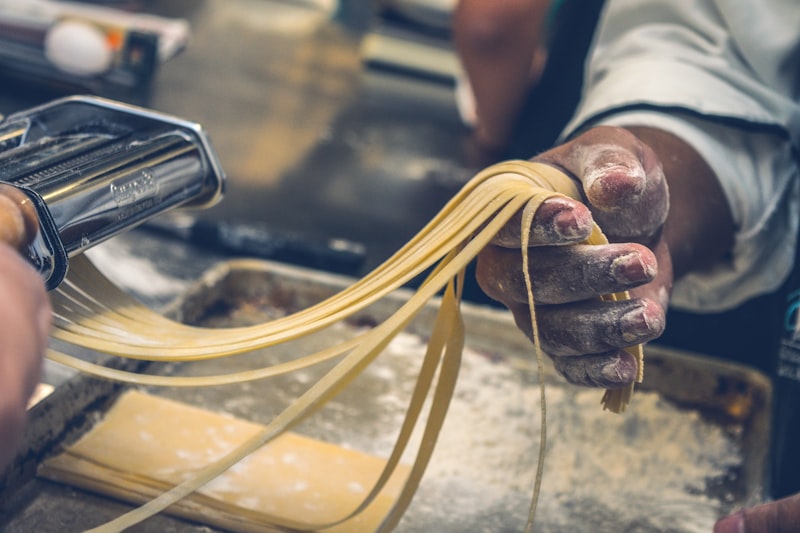Healthy cooking isn’t just about what you eat, but also about how you prepare your food. Adopting smart cooking techniques can significantly enhance the nutritional value of your meals while preserving their delicious flavors. Let’s explore some effective methods to keep your dishes both healthy and tasty.
One of the fundamental techniques in healthy cooking is steaming. Steaming vegetables, fish, or poultry helps retain their nutrients, as it doesn’t involve cooking them in direct contact with water. This method preserves vitamins and minerals that might otherwise leach out in boiling water.

Grilling is another fantastic option. It adds a smoky flavor to your food without the need for extra fats or oils. By grilling lean cuts of meat or vegetables, you can create dishes that are lower in calories and saturated fats compared to frying.

For those who enjoy a bit of oil in their cooking, stir-frying with minimal oil is an excellent choice. Quick cooking over high heat ensures that your ingredients retain their crunchiness and nutrients. Use heart-healthy oils like olive oil or sesame oil sparingly to enhance flavors without overpowering them.
Baking is a versatile technique that allows you to cook without adding excessive fats. Whether you’re baking chicken breasts or roasting vegetables, this method helps seal in flavors while maintaining the nutritional integrity of your ingredients.
Lastly, poaching is a gentle cooking method that involves simmering food in water or broth. It’s perfect for delicate proteins like fish or eggs, preserving their tenderness and nutritional value without the need for added fats.
By incorporating these healthy cooking techniques into your culinary repertoire, you can create meals that are not only nutritious but also bursting with flavor. Experiment with these methods to discover new ways to enjoy wholesome foods without sacrificing taste.
Mastering the Art of Oil-Free Cooking: Healthy Techniques for Every Meal
Are you ready to revolutionize your cooking with healthier choices? Oil-free cooking isn’t just a trend—it’s a smart way to enhance your well-being without sacrificing flavor. Whether you’re aiming to cut down on calories or reduce your intake of saturated fats, mastering oil-free cooking techniques can be a game-changer in your kitchen.

So, what exactly does oil-free cooking entail? It’s all about finding creative alternatives to traditional cooking oils that still bring out the best in your ingredients. Instead of relying on oil for sautéing, consider using vegetable broth or water. These substitutes not only keep your dishes light but also add a subtle depth of flavor.
Grilling and roasting are fantastic techniques that don’t require a drop of oil. By using a well-seasoned grill or a parchment-lined baking sheet, you can achieve that crispy texture and caramelization without excess fat. Imagine juicy vegetables or tender chicken breasts, perfectly cooked and bursting with natural flavors.
When it comes to baking, oil-free doesn’t mean taste-free. Applesauce, mashed bananas, or even yogurt can be fantastic replacements for oil in baked goods, ensuring they stay moist while adding a hint of sweetness. Experimenting with these alternatives not only boosts nutritional value but also invites a variety of tastes into your favorite recipes.
Salad dressings are another area where oil-free creativity shines. Blend fresh herbs, citrus juices, or even avocado for a creamy texture that dresses your greens beautifully. These homemade dressings not only elevate your salads but also provide essential nutrients that store-bought varieties may lack.
By mastering oil-free cooking techniques, you open up a world of possibilities for healthier, flavorful meals. Whether you’re starting small with a stir-fry or tackling a decadent dessert, each dish becomes an opportunity to nourish yourself and your loved ones. Ready to embark on this culinary adventure? Let’s make every meal a celebration of health and taste!
From Steaming to Grilling: The Best Methods for Nutrient-Rich Foods
Steaming is like nature’s gentle hug to your veggies and proteins. Imagine a steamy sauna for your food, where it’s enveloped in moist heat, retaining its natural vitamins and minerals. This method is perfect for delicate vegetables like broccoli and asparagus, preserving their vibrant colors and crunch. The best part? It’s simple – just a bit of water, a steaming basket, and voila! In no time, you have tender, nutrient-packed goodness on your plate.
On the other hand, grilling adds a kiss of smoky flavor that elevates your dishes to a whole new level. Picture juicy chicken breasts or portobello mushrooms sizzling over hot coals or a gas flame. The high heat seals in the flavors while giving a tantalizing char that enhances the taste buds. Plus, grilling is fantastic for lean meats, allowing fats to drip away, leaving behind lean, protein-rich goodness. It’s not just a cooking method; it’s a culinary experience.
But which method is truly the best for nutrient retention? Both have their merits. Steaming is superb for preserving water-soluble vitamins like vitamin C and B vitamins, which can leach out in other cooking methods. Meanwhile, grilling shines in retaining the inherent flavors and fat profiles of meats and vegetables alike. It’s a balance between gentle steaming and intense grilling – ensuring your food not only tastes fantastic but also nourishes your body efficiently.
Whether you opt for the tender embrace of steam or the fiery passion of a grill, each method offers a distinct way to enjoy nutrient-rich foods. Experiment with both to find your favorite, or better yet, alternate between them to savor the best of both worlds. After all, variety is the spice of life – and in this case, the secret to mouthwatering, nutrient-packed meals.
Sous Vide Secrets: Elevate Flavor with Precision Healthy Cooking
Have you ever wondered how top chefs achieve mouthwatering flavors and perfectly tender textures in their dishes? The secret lies in sous vide cooking, a technique that has revolutionized the culinary world. Sous vide, French for “under vacuum,” involves cooking food in vacuum-sealed bags immersed in a water bath at precisely controlled temperatures. This method ensures even cooking from edge to edge, preserving nutrients and enhancing flavors.
One of the key advantages of sous vide cooking is its precision. Unlike traditional methods where temperature control can be tricky, sous vide allows you to set the exact temperature you want your food to reach. Whether it’s a delicate piece of salmon or a hearty cut of steak, the sous vide method ensures consistent results every time. This precision not only guarantees food safety but also maximizes flavor retention.
Another benefit of sous vide cooking is its health advantages. By cooking food in vacuum-sealed bags, nutrients and natural juices are locked in, resulting in healthier meals without sacrificing taste. This makes sous vide ideal for those looking to maintain a balanced diet without compromising on flavor or texture.

Imagine serving your guests a perfectly cooked meal that melts in their mouths, each bite bursting with flavor and tenderness. Sous vide cooking makes this culinary dream a reality by allowing you to achieve restaurant-quality results in your own kitchen. Whether you’re a novice cook or a seasoned chef, mastering sous vide techniques can elevate your cooking skills to new heights.
Sous vide cooking is not just a cooking technique; it’s a game-changer for anyone passionate about delicious, healthy meals. Embrace the precision, unlock the flavors, and savor the delights of sous vide cooking in your culinary adventures.

This article aims to captivate readers by highlighting the benefits and allure of sous vide cooking while maintaining a conversational tone and emphasizing the impact on flavor and health.
Baking Better: How to Swap Ingredients for Healthier Treats
When it comes to baking, creating healthier treats doesn’t mean sacrificing flavor. By making smart ingredient swaps, you can enjoy your favorite baked goods guilt-free. Let’s explore some easy substitutions that pack a punch in both nutrition and taste.
One of the simplest swaps is replacing refined white flour with whole wheat flour. Whole wheat flour retains more nutrients and fiber, offering a heartier texture to baked goods. It’s a subtle change that enhances the nutritional value without compromising on texture.
For those with a sweet tooth, cutting down on sugar is crucial. Try substituting refined sugar with natural alternatives like honey or maple syrup. Not only do these add sweetness, but they also bring unique flavors to your treats. Remember, a little goes a long way!
To boost the nutritional profile further, consider using mashed bananas or unsweetened applesauce instead of butter or oil in recipes. These alternatives reduce saturated fats while adding moisture. Your muffins and breads will come out moist and flavorful every time.
For chocolate lovers, opt for dark chocolate chips over milk chocolate ones. Dark chocolate contains less sugar and more antioxidants, making it a healthier choice. It adds depth to cookies and brownies without overpowering the other flavors.
Lastly, don’t forget about adding nuts and seeds for extra crunch and nutrients. Whether it’s almonds, walnuts, or chia seeds, they can be mixed into batter or sprinkled on top for a wholesome twist.
By making these ingredient swaps, you’re not just baking; you’re crafting treats that are better for your body. Experiment with these substitutions to find your perfect balance of health and indulgence in every bite.
Quick and Healthy Stir-Fry Recipes for Busy Weeknights
Looking for quick and healthy meal options for those hectic weeknights? Stir-fry recipes are your perfect go-to solution! These dishes not only save time but also pack a punch of flavors and nutrients in every bite. Whether you’re a busy professional, a parent juggling multiple schedules, or simply someone who values a delicious homemade meal without the fuss, stir-fries can be your culinary savior.
What makes stir-fries so ideal for busy weeknights? It’s all about efficiency and versatility. You can toss together a vibrant stir-fry in a single pan, using fresh ingredients like colorful vegetables, lean proteins such as chicken or tofu, and wholesome grains like brown rice or quinoa. The key lies in the quick cooking process that retains the crunchiness of vegetables and the juiciness of meats, all while blending flavors with aromatic sauces and spices.
Imagine coming home after a long day, greeted by the aroma of sizzling garlic and ginger in the pan, with strips of tender beef or succulent shrimp cooking alongside crisp bell peppers and snap peas. The sound of ingredients dancing in the hot oil, creating a symphony of flavors, is both tantalizing and comforting.
Moreover, stir-fries are highly customizable. You can adjust the spice levels, swap ingredients based on what’s in your fridge, or even create themed stir-fries inspired by global cuisines. From savory soy sauce-based stir-fries to zesty teriyaki or tangy sweet and sour variations, the options are endless.
Nutritionally, stir-fries are a powerhouse. They retain more nutrients compared to dishes that involve prolonged cooking times. Plus, by controlling the amount of oil and sauces used, you can ensure a balanced meal that fits your dietary goals.
Frequently Asked Questions
What are some substitutes for unhealthy ingredients in recipes?
Discover healthier alternatives for common unhealthy ingredients used in recipes. Learn practical substitutes that enhance nutrition without compromising flavor.
What are the best methods for healthy cooking?
Discover the best methods for healthy cooking with our concise guide. Learn practical techniques to reduce oil and sodium intake while maximizing flavor. Explore tips on steaming, grilling, and using herbs and spices effectively to enhance nutritional value. Start creating delicious, nutritious meals today!
How can I retain nutrients when cooking vegetables?
Learn how to retain nutrients while cooking vegetables with simple methods such as steaming or microwaving instead of boiling, using minimal water, and cutting vegetables into larger pieces. These techniques help preserve essential vitamins and minerals, ensuring your vegetables remain nutritious.
How can I reduce oil and fats while cooking?
Learn effective methods to reduce oil and fats in your cooking with practical tips and techniques. Discover healthier alternatives and cooking practices that maintain flavor and texture while cutting down on unnecessary fats.
Is steaming a better option than frying for healthy meals?
Discover why steaming is often considered a healthier cooking method compared to frying. Learn about the benefits of steaming for preserving nutrients and reducing added fats, making it a preferred choice for healthier meal preparation.


